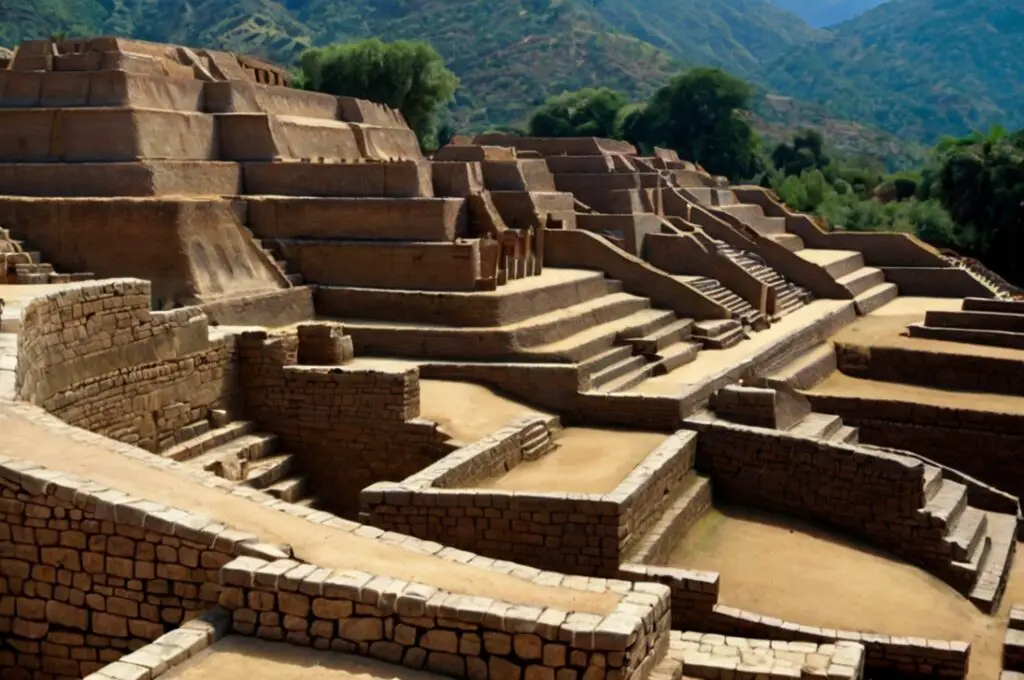
The Purépecha, often referred to as the Tarascans by the Spanish, were one of the most powerful civilizations in pre-Columbian Mexico.
Unlike many other Mesoamerican cultures, they successfully resisted Aztec conquest, managing to create an empire that thrived for several centuries.
The Purépecha civilization stood out due to its unique language, political organization, and cultural contributions, especially in art and architecture.
Today, the descendants of the Purépecha people continue to live in Michoacán, preserving elements of their rich heritage.
The Rise of the Purépecha
The Purépecha civilization emerged as a dominant force in Mesoamerica around the 14th century.
But their history stretches back much further, to a time when various communities were establishing themselves in western Mexico.
Origins and early history
The exact origins of the Purépecha people remain uncertain, as they did not have a written language like the Maya.
Some theories suggest they may have migrated from South America due to linguistic connections, while others believe they developed independently in the region that is now Michoacán.
Archaeological evidence suggests that they had settled in this region by around 1100 CE.
As the Purépecha communities grew, they organized into a kingdom with their capital at Tzintzuntzan, a city overlooking Lake Pátzcuaro.
From here, the Purépecha expanded their influence over surrounding areas, consolidating power and eventually forming an empire.
Political organization
The Purépecha developed a highly organized political system, ruled by a king known as the “Cazonci.” The Cazonci held ultimate authority over the empire, with a network of officials managing various aspects of governance, including administration, military, and religious matters.
The capital, Tzintzuntzan, was the political heart of the empire, where decisions on governance, law, and military strategies were made.
This well-structured political organization helped the Purépecha to effectively control their empire, which at its peak included parts of present-day Michoacán, Guanajuato, Guerrero, and Jalisco.
Military prowess
The Purépecha were known for their formidable military strength, which enabled them to resist Aztec attempts to conquer their lands.
In fact, the Purépecha were one of the few civilizations in Mesoamerica that the Aztecs could not defeat.
This resistance was largely due to their strategic use of resources and weaponry.
One of the Purépecha’s unique advantages was their mastery of metallurgy.
Unlike the Aztecs, the Purépecha were skilled metalworkers who crafted weapons and tools from copper, making their army highly equipped for battle.
Their advanced weaponry, combined with their well-organized military tactics, helped them maintain their autonomy and protect their territories.

Cultural Achievements
The Purépecha civilization made numerous cultural contributions, particularly in the fields of architecture, art, and spirituality.
Their unique style and techniques set them apart from other Mesoamerican civilizations.
Architecture and urban planning
The Purépecha built impressive structures, particularly their yácatas, which are terraced pyramids that served as both religious and ceremonial centers.
Yácatas were often constructed in unique circular and rectangular shapes, unlike the more angular pyramids of the Maya and Aztecs.
These structures were strategically placed in elevated areas to signify power and allow for defensive positioning.
Tzintzuntzan, the capital city, was filled with these structures, showcasing the Purépecha’s architectural skill.
Archaeological research suggests that Purépecha cities were meticulously planned, with designated spaces for ceremonies, markets, and residential areas, reflecting a sophisticated approach to urban organization.
Art and crafts
The Purépecha civilization was renowned for its exceptional craftsmanship, especially in pottery, textiles, and metalwork.
Purépecha artisans created intricate jewelry, tools, and religious items from copper and gold, showcasing their impressive skill with metals.
In fact, studies in the Journal of Archaeological Science suggest that Purépecha artisans were some of the most skilled metalworkers in Mesoamerica.
Their pottery and textiles were equally detailed and beautiful, often adorned with symbols of nature, animals, and gods.
Purépecha artisans had a unique skill for using natural dyes to create vibrant colors—a tradition that their descendants continue to honor and practice today.
Religion and spirituality
Religion was central to Purépecha life, with a pantheon of gods and goddesses who represented natural elements and forces.
One of the main deities was Curicaueri, the god of fire and the sun, who was considered the protector of the Purépecha people.
Religious rituals often involved offerings to the gods to seek blessings for a good harvest, protection in war, and health.
Purépecha priests held an important place in society, conducting ceremonies and overseeing religious practices.
The yácatas, or pyramid temples, served as the main sites for these rituals, which often included sacrifices.
Their religion was deeply connected to nature, and they believed in the importance of maintaining balance with their environment.

The Decline of the Purépecha
No civilization lasts forever, and the Purépecha were no exception.
While they managed to avoid conquest by the Aztecs, they could not escape the impact of Spanish colonization.
Factors leading to decline
When the Spanish arrived in Mexico in the early 16th century, the Purépecha attempted to negotiate, but eventually faced Spanish conquest.
The Spanish, led by conquistador Nuño de Guzmán, brought with them not only military force but also diseases like smallpox, which decimated the indigenous population.
The Purépecha were also forced into labor and had their lands taken over, leading to a rapid decline of their empire.
Colonization brought an end to their political structure, and many of their religious practices were suppressed.
Despite this, elements of Purépecha culture have survived to this day.
The Purépecha legacy
Though the Purépecha civilization faced decline, their legacy continues in many ways.
Today, the Purépecha people still live in Michoacán and other parts of Mexico, preserving their language, customs, and crafts.
The Purépecha language is still spoken by thousands of people, and their vibrant traditions in pottery, textiles, and metalwork remain strong.
The Purépecha’s influence can also be seen in Mexican culture, particularly in the Day of the Dead celebrations, which have roots in pre-Columbian religious practices.
The Purépecha community continues to honor their ancestors, preserving a connection to the past that highlights their resilience and cultural pride.

Final Thoughts
The Purépecha civilization is a remarkable example of a powerful, resilient culture that thrived in Mesoamerica.
Their contributions to art, architecture, and military strategy set them apart as one of the most influential societies in the region.
Despite facing the challenges of colonization, the Purépecha legacy lives on, a testament to their strength and adaptability.
By learning about and honoring their history, we gain a deeper appreciation for the richness of Mesoamerican culture.



